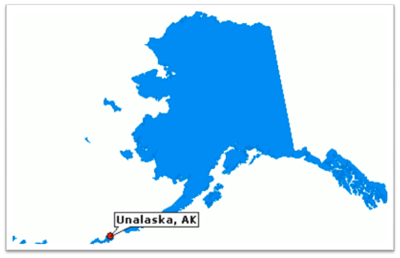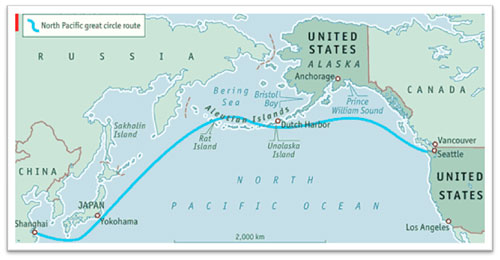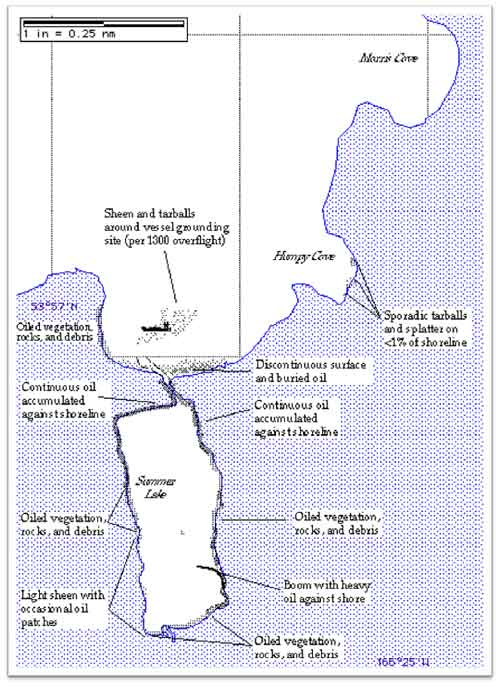This paper was written as part of the 2011 Alaska Oceans Sciences Bowl high school competition. The conclusions in this report are solely those of the student authors.
Increased Marine Transportation in Unalaska Bay and Its Future Implications
Authors
Team Frisky Phromina
Abstract
To the community of Unalaska, marine transportation is an important industry that brings in a large amount of revenue. Unfortunately, this industry comes with problems for Unalaska's precious ecosystems, mostly in terms of vessel accidents and marine debris. Unalaska has experienced several such devastating incidents in the past. According to data collected, we show that marine transportation traffic will only grow in the coming years. Along with this increase comes the probability of more harmful ecosystem disasters. In order to prevent more disasters from occurring, we have come up with an ecosystem-based approach to management that will regulate marine transportation. This plan includes researching Unalaska's ecosystems, setting up zones for incapacitated vessels, and setting stricter traffic lanes. In order to accomplish this, we have suggested that the city of Unalaska allot funding for said plan. By doing this, we hope to ensure that the ecosystems of Unalaska remain healthy, safe, and productive.
Introduction
The city of Unalaska is located on the island of Unalaska in the Aleutian Islands of Alaska (Figure 1). Unalaska is a small island city located approximately 800 miles southwest of Anchorage, Alaska, which is the closest larger city. As a small ocean-based fishing community with around 4,000 permanent residents and 2,000 to 5,000 transient workers, Unalaska relies heavily on its marine ecosystems. Unalaska is the largest fishing port in the United States by volume and the second in value. Though a substantial amount of Unalaska's revenue is from the fishing industry, transportation is the means to move fisheries product from one place to another and brings in a large amount of revenue to our city.
Transportation is one of the key facets to life in Unalaska and one of the biggest boosts to our local economy. Air and marine transportation bring most of the required staples to our island life. Everything from groceries, hardware supplies, and furniture is shipped in from Anchorage, Homer, and Seattle. Transportation also has a large impact on our community as we have thousands of tons of fisheries product that need to be exported to Anchorage, Seattle, and Japan. As the only deep-water, year-round, ice-free port from Unimak Pass to Adak, Unalaska is a vital rest and resupply stop for the thousands of vessels that transit the surrounding waters of the Aleutian Islands 12 months a year. Unalaska provides diesel fuel for 60% of vessels transiting Alaskan waters. Another thing that makes Unalaska vital to marine transportation is the fact that it lies only 50 miles from the Great Circle route, the shortest distance between East Asia and the Canadian-American Pacific Northwest (Figure 2). From 2008 to 2009, more than 2,200 vessels carrying at least 10,000 gallons of fuel or other hazardous materials transited Unimak Pass near Unalaska (Cox, 2010). Unalaska is a vital part of the world's marine transportation.
While transportation is incredibly important to our community's economy, there are also some adverse effects that it can have on marine ecosystems. Potential threats to local species include oil spills, derelict vessels, noise, pollution, direct interactions, and potentially invasive species.
We have seen first hand the impact of oil spills as we have experienced two very close to town in the last 25 years. In 1997, the Kuroshima, a Japanese cargo vessel, was anchored in Summer Bay Unalaska for three weeks when gale force winds hit. The ship's captain decided to try to weigh anchor and move the ship but because of the increasingly strong winds the ship ran into the bay at Priest Rock, releasing 47,000 gallons of oil into the Summer Bay Lake (Figure 3). In 2005, the Selendang Ayu, a Malaysian cargo ship, lost power in the Alaska Maritime National Wildlife Refuge. About a month later, the boat split in two, dumping a payload of 470,000 gallons of oil into the waters of Unalaska, along with 60,000 pounds of soybeans. After the incident, 1,503 dead birds were found and six dead mammals, thus making it the worst such spill since the Exxon Valdez (Brewer 2006).
There are thousands of ships that transit passed Unalaska each year and any time something goes wrong with one of those ships it is inevitably towed back to Unalaska. In 2006, the Cougar Ace, a cargo ship, listed at 80 degrees from vertical and was towed into Unalaska Bay. On board this ship was a load of almost 5,000 automobiles also listing at 80 degrees. Although none of the oil from the boat or the cars spilled into the ocean, it was estimated that if it had, 1,380,000 gallons of oil would have been spilt into the bay. Fortunately, after a week, a tugboat from Seattle arrived and towed it to Vancouver, where all of the automobiles were immediately disposed of. Another example is the Selica Frigo, a 450 foot freighter with a few capacity of 450,000 gallons lost power and was pushed aground in Unalaska Bay by 60 mile per hour winds in March of 2007.
Noise, small scale pollution, direct interactions with wildlife and invasive species are all negative impacts associated with increased boat traffic, but are a bit harder to measure as the impacts are felt underwater and out of sight. More vessel traffic will likely mean more noise and more vibrations in the water. Marine fish, birds, and mammals all have sensitive sensory systems that could easily be disturbed by increased traffic. All boats and vessels leak small amounts of fluids that could have a significant effect on the health of local wildlife and may cause certain species to move to other areas. Unalaska Bay plays host to several hundred humpback whales and dozens of seals, sea lions, and sea otters and the potential for a direct interaction with a 450-foot vessel becomes more likely with more traffic.
One example of this was in November of 2006, when an un-named fishing vessel rounded the corner coming into to Unalaska Bay in the early morning. The crew turned on the sodium lights to avoid any physical obstacles and ended up causing a full-scale riot for 100,000 short-tailed shearwaters that were floating nearby. The lights on the vessel confused and blinded the birds and birds crashed into the vessel and rigging for over 30 minutes. Crewmembers reported shoveling bird carcasses off the deck of the vessel that piled 3 feet high. Over the next few days, local volunteers counted over 5,000 bird carcasses on local beaches and because many of the birds were likely washed out to sea or to unreachable beaches, the number of bird deaths was likely to be around 20,000. Though this is an extreme example, the point is that increased traffic will likely cause more of these types of incidents. One of the unseen potentials that has yet to be addressed near Unalaska is ballast water invasive species. With Unalaska's suite of international vessels, invasive species traveling in ballast water could likely compete with local species causing a disruption in the flow of the native ecosystem.
According to the International Transport Forum, shipping activity has increased significantly over the last century, and will continue to do so in the coming years. With the increased oil exploration around the North Slope, decreased ice in the Arctic, and other needs for a deep-water port for transiting vessels, Unalaska will likely see a large increase in the number of vessels transiting local waters. Our project was to come up with an ecosystem approach to managing our local wildlife resources so that we can lessen the impacts of this increase and preserve our way of life.
Unalaska's Ecosystem
The ecosystem that we are referring for the purposes of this project is the Unalaska Bay ecosystem. The near shore ecosystem is made up of rocky to sandy shorelines, kelp forests, estuaries, and shallow reefs. Unalaska Bay acts as a nursery for many juvenile fish and invertebrate species to include commercially important species like walleye pollock, Pacific cod, Pacific halibut, and many species of salmon. The local bay area is home to several species of shore and sea birds as well as a variety of marine mammals that feed on the many species that come into Unalaska Bay. Unalaska Bay often plays host to ESA listed humpback whales, Steller sea lions, and northern sea otters.
There are several subsistence and sport fisheries that take place in Unalaska Bay as well as a few commercial fisheries. Sport and subsistence fisheries include salmon, tanner crab, red king crab, blue mussels, razor clams, Pacific halibut, Pacific cod and others. Commercial fisheries that occur in Unalaska Bay include Pacific herring, salmon, and walleye pollock. There are several mammal hunters on the island of Unalaska, although their annual take is less than a few seals and sea lions each year.
One final aspect of the Unalaska ecosystem is the people that interact and depend so heavily on the ocean environment. Though there are approximately 4,000 year-round residents, Unalaska plays host to several thousand visitors that travel by air and sea. Most of the people in Unalaska make their living in fisheries, fisheries support, or fisheries service support. The local tribe called the Qawalangin Tribe has many active members and programs and is a constant voice for coastal stewardship.
Ecosystem Approach to Management
Though transportation is necessary to the community of Unalaska and will likely increase in future years, we have come up with an ecosystem approach to manage and hopefully minimize the impacts of this increase.
Because we have had oil spills in Unalaska before, the first thing we need to do is better understand the current state of our beaches and local wildlife. There is no sediment testing being performed and therefore we have no idea of the state of pollution for our beaches. We would recommend a large-scale, baseline study be performed in Unalaska Bay beginning with sensitive and high-use areas like estuaries, salmon streams, or subsistence fishing areas. By determining the state of these resources we will have a comparison for when (not if) the next spill occurs.
Unalaska will likely always be a hub for disabled vessels to get repairs or protection from weather. We would like to set up a containment area that vessels could be towed and dealt with without any potential impact to the environment or our wildlife resources. Such an area would have to be completely contained on all sides and dimensions. By isolating disabled vessels, we might reduce the potential impacts of contaminating our environment. For this we would need to find a way to build the containment area, what material to use, relation of the site to water currents, and other potential confounding facts such as worst-case scenario weather.
Though noise will be difficult to manage, we can manage the direct interactions with local wildlife to enforcing strict travel lanes for incoming and outgoing traffic. By causing boats to stick to corridors of travel in a single file, we might be able to decrease the breath of the impact vessels may be having on visiting whales, sea lions or others.
Invasive species through ballast water is a worldwide threat that we don't really know how to deal with yet. We would manage ballast water coming into local bays by requiring ballast-carrying vessels to exchange their ballast water while 10 miles away from shore. When international vessels come through the US, they are required by law to exchange their ballast water 200 miles from shore in water greater than 2,000m (United States Ballast Water, 2010), but would like a second exchange to ensure there aren't any small spatial scale re-settlements or difficult to release invasive trapped.
Though the City of Unalaska is already looking into funding high seas tugs and has annual emergency tow exercises, we would also encourage local emergency response training for the small boat fleet. During the Selendang Ayu oil spill, we had four days of calm weather after the Selendang ran aground in which locals could have responded. By the time the Unified Command system was up and running, we had another storm hit that kept responders out of the spill area for another seven days. Locals do care about their environment and would have been willing to do there part if given the signal.
Our ecosystem approach to managing increased traffic in Unalaska Bay involves establishing baseline information about the health status of our coastline and wildlife, isolating derelict vessels from the environment, minimizing direct impact with wildlife by using stricter traffic lanes, increasing ballast exchange, and having emergency supplies and training available locally. By implementing these programs, we will have some measure of control over our water resources, coastlines, local wildlife, and the safety of our people.
In addition to our ecosystem approach to management we have asked the city of Unalaska for one million dollars in grant money to fund the following research priorities:
- $200,000 for a baseline evaluation of near-shore health. This priority area deals with establishing baseline information about coastal resources to include water and sediment sampling, invertebrates, fish, birds or mammals.
- $200,000 for seafloor mapping and channel improvements. This priority is aimed at reducing the potential for vessels to wreck on shore and/or reduced vessel impacts on wildlife
- $200,000 for creating innovative ways to isolate derelict vessels.
- $100,000 for hazardous material response training.
- $100,000 for training programs for locals and equipment caches.
- $100,000 for invasive species monitoring. This priority deals with monitoring local shorelines for invasive species or ballast water research.
- 200,000 for modeling of traffic impacts on the environment. This priority is focused on establishing the current impact of transportation in the ecosystem of Unalaska Bay and predicting how increased future traffic might impact resources.
We feel that with this funding and research will come a degree of preparation and awareness to our town that will prevent future catastrophes similar to the ones we have experienced in the past.
Conclusion
In conclusion, Unalaska Bay is a diverse and thriving ecosystem that sits at the juncture of marine transportation for many eastern countries. Although this transportation brings in a large amount of revenue to the city of Unalaska and is vital to Unalaska's fishing industry, it carries with it the possibility of large and small-scale harm to the Unalaska bay ecosystem. While we welcome the predicted increase in transportation traffic and revenue, we must make sure that our town remains prepared for any possible accidents. In order to accomplish this, we have presented research and preparation that we believe will drastically decrease the likelihood of such accidents. If funded, the research and preparation we suggested could save the Unalaska bay ecosystem from future harm, allowing it to thrive. If the Unalaska Bay ecosystem thrives, Unalaska itself will thrive as well.
Figures
Works Cited
- Betzen, N., et al. "The Impact of Receding Sea Ice on the Unalaska Snow Crab Industry." The National Ocean Sciences Bowl, Alaska Region. Seagrant.uaf.edu. 2009. Web. Nov 25, 2010. http://seagrant.uaf.edu/nosb/papers/2010/unalaska-bean.php
- Brewer, R. The Selendang Ayu Oil Spill: Lessons Learned. Proceedings from the Aleutian Life Forum 2005. May, 2006. 124. Print.
- "A Cold Coming We Had of It." The Economist. Economist.com. Jan 18, 2007. Web. 29 Nov, 2010. http://www.economist.com/node/8570527
- Cox, R. "Dutch Harbor's Emergency Tow System Spreads to Other Ports." Dutch Harbor Fishermen. 2010. Print.
- Curtis, R. "Learning from Alaska" ibrrc.org. April 30, 2005. Web. 29 Nov, 2010. http://www.bird-rescue.org/
- Endersen, O., et al. "The Environmental Impacts of Increased International Maritime Shipping." OECD International Transport Forum. Oecd.org. 10-12 Nov, 2008. Web. Nov 29, 2010. http://www.oecd.org/dataoecd/52/30/41373767.pdf
- Guinotte, J. Ocean Acidification and Its Potential Effects on Marine Ecosystems. Wiley Online Library. Onlinelibrary.wiley.com. 28 Jun 2008. Web. Nov 29, 2010. http://onlinelibrary.wiley.com/doi/10.1196/annals.1439.013/abstract
- NOAA. "NOAA Final Report for the M/V Kuroshima Response." akrrt.org. April, 1998. Web. 29 Nov, 2010. http://www.akrrt.org/Archives/Response_Reports/AAR_Kuroshima_NOAA_1997.pdf
- Rodrigue, J.-P. "The Environmental Impacts of Transportation." Hofstra University. People.hofstra.edu. 1998. Web. Nov 29, 2010. http://people.hofstra.edu/geotrans/eng/ch8en/conc8en/ch8c1en.html
- "United States Ballast Water Regulation." el.erdc.usace.army.mil. N.d. Web. 1 Dec, 2010. http://el.erdc.usace.army.mil/zebra/zmis/zmishelp/united_states_ballast_water_regulations.htm





